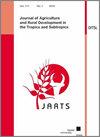In the search for low-cost year-round feeds: Pen-level growth performance of local and crossbred Ugandan pigs fed forage- or silage-based diets versus commercial diet
Q3 Social Sciences
Journal of Agriculture and Rural Development in the Tropics and Subtropics
Pub Date : 2018-12-04
DOI:10.17170/KOBRA-2018112824
引用次数: 2
Abstract
Smallholder pig farmers in East Africa report that lack of feed, seasonal feed shortages, quality and cost are key constraints to pig rearing. Commercially prepared pig diets are too expensive and people and pigs compete for food. Smallholder farmers typically feed nutritionally unbalanced diets, resulting in low average daily gain (ADG) and poor farmer profits. Our objective was to compare the ADG of Ugandan pigs fed forage- or silage-based or commercial diets. Ugandan weaner-grower pigs were randomly assigned to forage- or silage-based diets or commercial diet. Pigs were weighed every 3 weeks from 9 to 32 weeks of age. Pen-level ADG and feed conversion were compared across diets using multiple linear regression. The ADG of pigs fed forage- or silage-based diets was lower than those fed commercial diets between 9 and 24 weeks of age ( p < 0.05). Between 28 and 32 weeks, pigs fed forage-based diets had lower ADG than those on other diets ( p < 0.05). Least squares mean ADG (g/pig/day) for pigs fed forage- or silage-based diets or commercial diet were 36, and 52, and 294 respectively at 9–15 weeks; 163, 212, 329 at 15–19 weeks; 112, 362, 574 at 20–24 weeks and 694, 994, and 1233 at 28 to 32 weeks of age. It was concluded that forage- and silage-based diets are unsuitable for small, newly weaned pigs. Feeding forage- or silage-based diets to finishing pigs is more suitable. Forage- and silage based diets are year-round low-cost pig-feeding strategies that will improve the growth performance of East African pigs, thereby increasing pig farmer income and food security.寻找低成本的全年饲料:饲喂草料或青贮饲料与商业饲料的地方和杂交乌干达猪的栏级生长性能
东非的小型养猪户报告说,饲料缺乏、季节性饲料短缺、质量和成本是制约养猪的主要因素。商业准备的猪饲料太贵,人和猪争夺食物。小农通常采用营养不均衡的饲料,导致平均日增重低,农民利润微薄。我们的目的是比较乌干达猪饲喂饲料或青贮饲料或商业饲料的平均日增重。乌干达断奶猪被随机分配到以饲料或青贮饲料为基础的日粮或商业日粮。9 ~ 32周龄,每3周称一次体重。采用多元线性回归对不同饲粮的日增重和饲料系数进行比较。9 ~ 24周龄饲粮的平均日增重低于商品饲粮(p < 0.05)。28 ~ 32周时,饲粮中添加饲料的平均日增重低于其他饲粮(p < 0.05)。9-15周时,饲粮为青贮料型饲粮和商品饲粮的最小二乘平均日增重(g/头/天)分别为36、52和294;15-19周163人,212人,329人;12、362、574周龄在20-24周,694、994、1233周龄在28 - 32周。由此可见,以饲料和青贮为基础的饲粮不适合初断奶仔猪。饲粮以牧草或青贮饲料为基础较为适合育肥猪。以牧草和青贮饲料为基础的日粮是全年低成本的猪饲养策略,将提高东非猪的生长性能,从而增加养猪户的收入和粮食安全。
本文章由计算机程序翻译,如有差异,请以英文原文为准。
求助全文
约1分钟内获得全文
求助全文
来源期刊
CiteScore
2.30
自引率
0.00%
发文量
0
审稿时长
>36 weeks
期刊介绍:
The Journal of Agriculture and Rural Development in the Tropics and Subtropics publishes papers dealing with original research and review papers in the fields of plant production, animal nutrition and animal husbandry, soil science, rural economy and farm management, forestry and forest economy, veterinary hygiene and protection against epidemics.

 求助内容:
求助内容: 应助结果提醒方式:
应助结果提醒方式:


